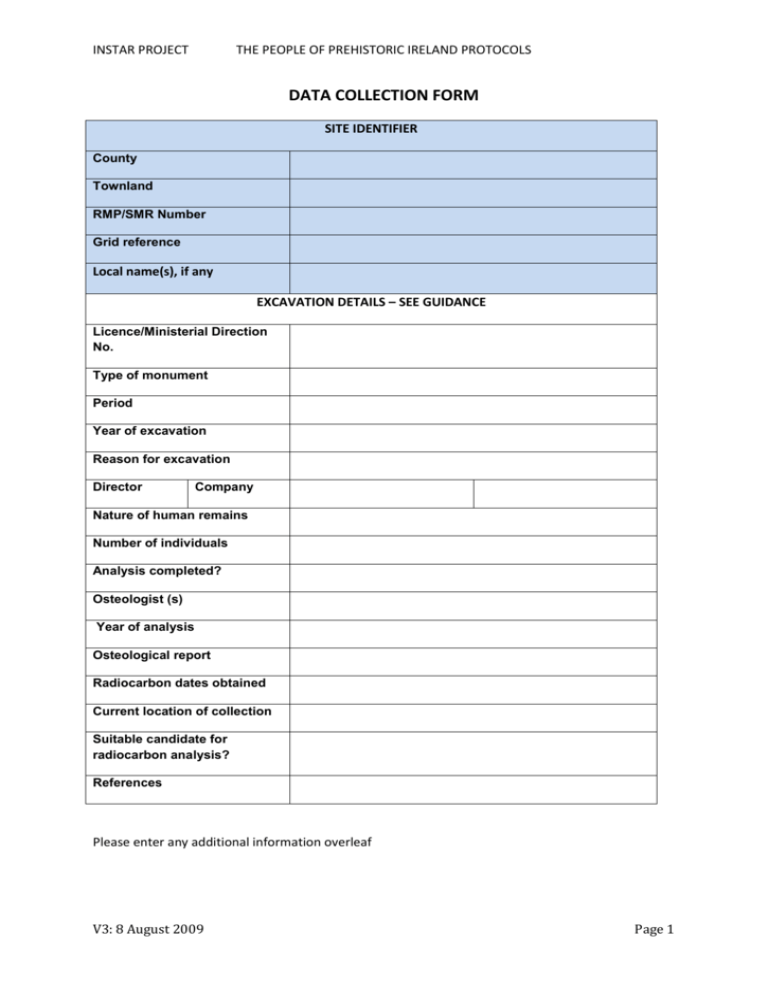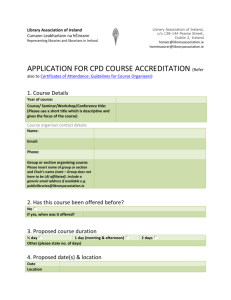
INSTAR PROJECT
THE PEOPLE OF PREHISTORIC IRELAND PROTOCOLS
DATA COLLECTION FORM
SITE IDENTIFIER
County
Townland
RMP/SMR Number
Grid reference
Local name(s), if any
EXCAVATION DETAILS – SEE GUIDANCE
Licence/Ministerial Direction
No.
Type of monument
Period
Year of excavation
Reason for excavation
Director
Company
Nature of human remains
Number of individuals
Analysis completed?
Osteologist (s)
Year of analysis
Osteological report
Radiocarbon dates obtained
Current location of collection
Suitable candidate for
radiocarbon analysis?
References
Please enter any additional information overleaf
V3: 8 August 2009
Page 1
INSTAR PROJECT
THE PEOPLE OF PREHISTORIC IRELAND PROTOCOLS
GUIDANCE FOR COMPLETION OF DATA COLLECTION FORM
GENERAL
In the case of multi-period sites and/or where multiple excavations have taken place and/or
where multiple types of burial have taken place, a separate form should be completed for
each.
Cells should be deliberately left blank where the required information is not available. No
information is to be entered in any field unless it complies with the protocols below.
The end date for inclusion of recently-discovered/re-excavated sites will be 31 December
2008.
SITE IDENTIFIER
This section of the form is the unique identifier of the site. Details here should remain the same,
even where multiple excavations have taken place and where different types of monument or
burials have occurred at the site. For example, the site may be classified as a passage tomb (itself a
monument) and the site identifier will correspond with this. However, there may be later insertions
(or monuments) into the original structure, such as cist or urn burials. The site details will remain the
same, but individual features will require separate forms to avoid confusion. The details from all
monuments on the same site will be recorded on one horizontal line in the database.
COUNTY
County Names (as determined by the Ordnance Survey of Ireland and the Ordnance Survey of
Northern Ireland) and RMP/SMR abbreviations (as determined by the Department of the
Environment, Heritage and Local Government [DEHLG] and the Northern Ireland Environment
Agency [NIEA]) are as follows:
COUNTY
ANTRIM
ARMAGH
CARLOW
CAVAN
CLARE
CORK
DONEGAL
DOWN
DUBLIN
FERMANAGH
GALWAY
KERRY
KILDARE
KILKENNY
LAOIS
LEITRIM
LIMERICK
V3: 8 August 2009
ABBREVIATION
ANT
ARM
CW
CV
CL
CO
DG
DOW
DU
FER
GA
KE
KD
KK
LA
LE
LI
COUNTY
LONDONDERRY
LONGFORD
LOUTH
MAYO
MEATH
MONAGHAN
OFFALY
ROSCOMMON
SLIGO
TIPPERARY NORTH
TIPPERARY SOUTH
TYRONE
WATERFORD
WESTMEATH
WEXFORD
WICKLOW
ABBREVIATION
LDY
LF
LH
MA
ME
MO
OF
RO
SL
TN
TS
TYR
WA
WM
WX
WI
Page 2
INSTAR PROJECT
THE PEOPLE OF PREHISTORIC IRELAND PROTOCOLS
TOWNLAND
Names are as determined by the DEHLG and NIEA, as some monuments are not located in an OS
townland and a pseudo townland name may have been given by these organisations in order to
assist in data processing. Where a monument is located across a number of townlands, these should
all be listed, with the principal townland underlined.
RMP or SMR NUMBER
In the Republic of Ireland, each monument is given a unique number, entered on the Record of
Monuments and Places (RMP) and detailed information is held by the Archaeological Survey of
Ireland. Records are held on a county basis, with each county having its own designated letters (see
above). The correct format is, for example DG 097-017001. Similarly, in Northern Ireland,
monuments are given a unique number on the Sites and Monuments Register (SMR), with details
held by the Historic Monuments Unit, Northern Ireland Environment Agency. The correct format is,
for example TYR 021:007. In the case of sites recently discovered, an RMP or SMR number may not
yet have been allocated and the site recorded by its Licence or Ministerial Direction number (below).
GRID REFERENCE
Map references for archaeological sites are currently held in several formats. It is recognised that
the Ordnance Survey of Ireland and Ordnance Survey of Northern Ireland are moving from Irish Grid
to Irish Transverse Mercator referencing, but this has not yet been achieved. Accordingly, grid
references in this database will be as recorded in the original documentary source and will be
amended in due course.
LOCAL NAME(S), if any.
This cell is for the recording of any local name for the monument, such as Ossian’s Grave for
Lubitavish Court Tomb (ANT 019:006). The same name may be used for several other monuments.
Cartographic references such as Druid’s Altar should also be entered here.
EXCAVATION DETAILS
LICENCE/MINISTERIAL DIRECTION NUMBER
This is to be added only where an SMR number has not yet been issued. In some ROI road schemes,
the Ministerial Direction number will be issued instead of a licence number. Only one reference is
required here, either will do.
TYPE OF MONUMENT
This should be in accordance with the classifications determined by DEHLG and NIEA. No other
classification should be used. Each type of monument or burial on the site should have its own entry.
V3: 8 August 2009
Page 3
INSTAR PROJECT
THE PEOPLE OF PREHISTORIC IRELAND PROTOCOLS
PERIOD
The categories recorded here should be as follows:
Mesolithic
Neolithic
Bronze Age
Iron Age
If it is a multi-period site, all the details pertaining to each category (as above) will be listed as a
complete entry to avoid confusion. No other categories or sub-divisions should be used.
YEAR OF EXCAVATION
Only the year is required here, not month/day etc. Where a site has been excavated over several
consecutive seasons, enter only the first year. Each year to be entered fully, as, for example 1991,
2002, 2004. Not 2001-2 or 04 etc. Where a monument has been excavated on more than one
occasion, this is to be considered as a separate entry.
REASON FOR EXCAVATION
Entries here should be either:
Rescue
Research
Accidental (where remains have been discovered accidentally and documented, but not scientifically
excavated).
DIRECTOR/COMPANY
Director here refers to the person in charge of the excavation. This includes antiquarians, unlicensed
excavators and landowners. Surname, then initials, for example Williams, B.B. Omit any titles, such
as Dr, Mr, etc. If the name is unknown, enter Unknown. Organisation names should be given in full,
such as Northern Ireland Environment Agency, not NIEA. Addresses are not required.
NATURE OF HUMAN REMAINS
Only the following categories should be used:
CREMATED
INHUMATION – applies to human remains that were articulated at the time of burial
DISARTICULATED – this applies to unburnt bone that has been crushed or fragmented. Also includes
what may also be referred to as ‘decayed bone’.
V3: 8 August 2009
Page 4
INSTAR PROJECT
THE PEOPLE OF PREHISTORIC IRELAND PROTOCOLS
UNDIFFERENTIATED – this applies to human remains with insufficient analysis carried out to
categorise (for example OS Memoir sites)
Where multiple types are present, all should be listed as separate entries (as above).
NUMBER OF INDIVIDUALS
The number recorded here must be:
MNI (as confirmed by osteological analysis).
MULTIPLE (If analysis not been carried out, but more than one individual is suspected).
N/A (number not available).
ANALYSIS COMPLETED
This is where an analysis has been carried out by an osteologist and report prepared. It also refers to
earlier analysis carried out by medical personnel, such as Dr Morton of the Anatomy Department,
Queen’s University.
OSTEOLOGIST(S)
Name(s) of osteologists as above. Surname, then initials, for example, McGranaghan, C. Omit any
titles, such as Dr, Mr etc.
YEAR OF ANALYSIS
Year only required here. For multiple reports, list all years as separate entries (as above).
OSTEOLOGICAL REPORT
Entries here should only be in the following form:
Published (provide full bibliographical details in References below)
Unpublished
This section should not be used for excavation reports, unless this is the only source of information
available.
RADIOCARBON DATES OBTAINED
These are given in a variety of formats. In this database, the preferred format is as follows:
Lab Code
Sample ID
δ 13 C (VPDB)
Radiocarbon age
UB –xxxx
Date 1
-23.6 ‰
2424 ± 20 BP
UB - yyyy
Date 2
-26.2 ‰
(after Barratt and Reimer 2007, 11)
2424 ± 20 BP
V3: 8 August 2009
Calibrated age
ranges (2σ)
731-691 cal. BC
660-652 cal. BC
544-406 cal. BC
405-381 cal. BC
Relative
probability
0.118
0.016
0.866
1.000
Page 5
INSTAR PROJECT
THE PEOPLE OF PREHISTORIC IRELAND PROTOCOLS
Note – where information is not available in the approved format, enter all available data, including
lab code.
CURRENT LOCATION OF COLLECTION
Use this cell for information on the current (2009) known location of collections of human remains
pertaining to the site entry. Entries should be in the following format:
Ulster Museum, National Museum of Ireland, Louth County Museum etc.
NIEA, DEHLG
EACHTRA, Northern Archaeological Consultancy, etc.
Lost
Re-buried on site
SUITABLE CANDIDATE FOR RADIOCARBON ANALYSIS
The suitability of a bone sample for radiocarbon analysis will depend on a number of factors, such as
its origin in a particular monument type, the condition of the sample, a unique feature of the sample
or its location, etc. Due to budget limitations, the final decision on selecting bone samples will be
made by Dr Eileen Murphy or Dr Barra Ó Donnabhaín.
REFERENCE
Here, all bibliographical references are required, in full, in accordance with the following guidance:
Book
Cobbett, W. 1979. Cottage Economy (reprint of 1850 edition). Oxford: Oxford University Press.
Crawford, S. 1999. Childhood in Anglo-Saxon England. Stroud: Sutton.
Cunningham, H. 2005. Children and Childhood in Western Society Since 1500 (second edition).
London: Pearson Longman.
Duby, G. 1968. Rural Economy and Country Life in the Medieval West (translated from 1962 French
edition by C. Postan). London: Edward Arnold.
Huskinson, J. 1996. Roman Children’s Sarcophagi: Their Decoration and its Social Significance (Oxford
Monographs on Classical Archaeology). Oxford: Clarendon Press.
Scott, E. 1999. The Archaeology of Infancy and Infant Death (BAR International Series 819). Oxford:
Archaeopress.
Sofaer-Derevenski, J. (ed.). 2000. Children and Material Culture. London: Routledge.
Journal Article
V3: 8 August 2009
Page 6
INSTAR PROJECT
THE PEOPLE OF PREHISTORIC IRELAND PROTOCOLS
Donnelly, S., Donnelly, C. and Murphy, E. 1999. The forgotten dead: the cilliní and disused burial
grounds of Ballintoy, County Antrim. Ulster Journal of Archaeology 58, 109-13.
Smith P. and Kahila, G. 1992. Identification of infanticide in archaeological sites: a case study from
the Late Roman-Early Byzantine periods at Ashkelon, Israel. Journal of Archaeological Science 19,
667-75.
Paper in Edited Volume
Jalland, P. 1999. Victorian death and its decline: 1850-1918, pp. 230-55 in Jupp, P. C. and Gitting, C.
(eds.), Death in England: An Illustrated History. Manchester: Manchester University Press.
Thesis
Amorosi, T. 1996. Icelandic Zooarchaeology: New Data applied to Issues of Historical Ecology.
Unpublished Ph.D. thesis, City University of New York.
Unpublished Report
Buckland, P. 1995. St George’s School, Margaret Street, Walmgate, York. The insect remains (appendix),
in Foster, P. and Symonds, J., An archaeological evaluation at St George’s School, Margaret Street,
Walmgate, York. Unpublished ARCUS report 208, University of Sheffield.
Hall, A. R., Kenward, H. K. and Robertson, A. 1993c. Investigation of medieval and post-medieval plant
and invertebrate remains from Area II of the excavations in The Bedern (north-east), York (YAT/Yorkshire
Museum sitecode 1976-81.14 II). Unpublished Ancient Monuments Laboratory Report 58/93.
V3: 8 August 2009
Page 7






